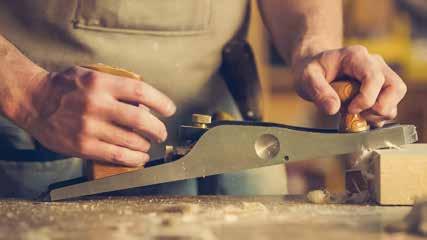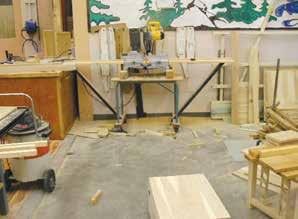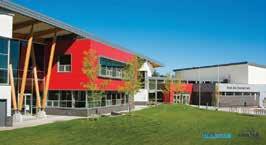
5 minute read
Wood dust and carcinogens
By alan kavanaugh, CrM, CCPi (MeMBer nFPa)
Over the past several years there has been an increase in inspection activity and updates of dust collection systems in regards to industrial arts (IA) technology wood shops located in many high schools and middle schools. It should be noted that the primary focus of the Dust Mitigation program for these types of occupancies deals with the prevention of explosions and subsequent fires. In this article, we will discuss the potential health concerns, and in particular, potential cancer concerns in regards to wood dust and exposure to wood dusts in school shops.
Exposure to wood dust has long been associated with a variety of adverse health effects, including dermatitis, allergic respiratory effects, mucosal, and non-allergenic respiratory effects and cancer.
It should also be noted that the International Agency for Research on Cancer (IRAC) has classified wood dust as a carcinogenic to humans. A study completed in 1965 observed that a large number of furniture workers and other wood workers exposed to wood dust in England developed a rare form of nasal cancer (Adenocarcinoma).

In this study, the highest risks appear to be to those workers exposed to hardwood dust including beach and oak, as well as various other tropical species. There have also been attributed allergic reactions in regards to people working with cedar. It was also noted in this study that the cancer developed on-average over a 20-year period and that most of the exposure levels were much higher than those seen in today’s industry.
Worksafe BC in their section on occupational cancers refers to workers involved with furniture and cabinet-making as being exposed to a form of nasal cancer from wood dust. Safety Data Sheets (SDS) sourced on pine sawdust and the Tampa International Forest Products sheet on hazard warning for untreated wood dust and wood products also discuss potential carcinogenic exposures from wood dust, in particular nasal cancer. There are other studies taking place at this time.
Worksafe BC and OH&S organizations are designed to provide recommendations, guidelines, and regulations to ensure a safe work environment is provided for all employees in the workplace. Worksafe BC and other organizations have provided documented exposure limits for many types of biological and chemical substances, including wood dust.
Controlling exposure
All safety programs should have policies and procedures, as well as references to documentation like Worksafe BC and OSHA regulations. They should include an ongoing risk analysis system, which is continuing to accumulate information at all times, noting potential risky and hazardous operations so plans can be developed to mitigate potential for injury and subsequent losses.
Finer dusts appear to have more of an exposure to workers that other wood-type flying’s.
Basic Safety – Reducing exposures to wood dust
1. Standard ventilation (dust-control systems) should be provided. 2. Dust-control systems should be cleaned, inspected, and maintained on a regular basis. 3. Filter masks should be worn. 4. Eye and face protection should always be provided. 5. Type of wood (species) should be investigated before use to ensure it is safe to use in a school environment.
Conclusion
So in closing, remember the following steps:
1. Conduct a Risk Analysis or Needs
Assessment:
This is the Who, What, Where, Why, and When section.
Exposure to wood dust has long been associated with a variety of adverse health effects, including dermatitis, allergic respiratory effects, mucosal, and non-allergenic respiratory effects and cancer.

2. Accumulate information on your IA
Technology Shops (Safety Surveys):
The more information you have, the better informed your final decisions will be. 3. Identify all Risks/Hazards:
Allows you a starting point from which to develop plans on ways of mitigating potential losses from occurring. Be specific. 4. Monitor your progress, make changes if needed:
Sunnyside Elementary School courtesy of Grant + Sinclair Architects JL Crowe Secondary School
Stay informed. Many changes take place on a regular basis in regards to safety equipment, facility safety, dust mitigation, health issues, as well as the needs for continued maintenance and repair procedures for existing facilities.
Talk to risk management professionals – people in your industry, other teachers, staff, and various other organizations. Someone may have tried an idea already that you are thinking about using. n
Commercial Industrial Healthcare Education Government Residential Vancouver 604-526-3154
Prince George 250-564-6178
www.TheFilterShop.com
Manufacturing & Distribution of HVAC Filtration Products Across Western Canada
Martha Currie Elementary School courtesy of Schubert Plumbing Mar Jok Elementary School Courtesy of Think Space & Sawchuck Rogers Elementary School
Alan Kavanaugh is the senior risk manager at Suncorp Valuations. He has provided risk management services to school districts/ divisions, municipalities, industry, and government operations for over 30 years. He has developed a set of training programs (workshops) and audits (safety related) to help all organizations accumulate and prioritize information and develop short- and long-term compliance plans. Kavanaugh is based out of Prince George, B.C. but provides services throughout Western Canada and the Territories. He can be reached by email at alan.kavanaugh@suncorpvaluations. com, or by phone at 800-764-4454,
PLEASE RECYCLE.
Lynn Fripps Elementary
ext. 7102, or cell 250-612-1935.
Courtesy of Craven Huston Powers Architects
Royal Bay Secondary

ME CHA NICAL C ONS UL TI NG ENGI NE ERS

Contact us today at one of our seven BC locations to learn more about how we can provide you with intelligent building engineering solutions for your school facilities or other buildings

VANCOUVER
102 – 211 E. Georgia Street Vancouver, BC V5T 4L6 Phone: 604-559-8809
LANGLEY
#208 - 20171 92A Avenue Langley, BC V1M 3A5 Phone: 604-888-7779
VICTORIA
202 -1701 Island Highway Victoria BC V9B 1J1 Phone: 250-704-4427
NANAIMO
#102 - 3721 Shenton Road Nanaimo, BC V9T 2H1 Phone: 250-585-0222
KELOWNA
#201 - 1420 St. Paul Street Kelowna, BC V1Y 2E6 Phone: 250-763-3759
KAMLOOPS
#202 - 1339 McGill Road Kamloops, BC V2C 6K7 Phone: 778-471-6472
NELSON
#2 – 373 Baker Street Nelson, BC V1L 4H6 Phone: 250-352-7933
For more information visit our website at www.rpeng.ca










